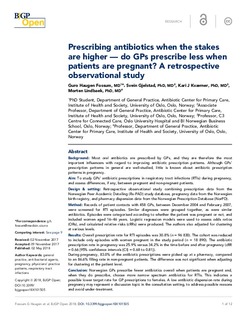Prescribing antibiotics when the stakes are higher — do GPs prescribe less when patients are pregnant? A retrospective observational study
Journal article, Peer reviewed
Published version
Permanent lenke
http://hdl.handle.net/11250/2570864Utgivelsesdato
2018Metadata
Vis full innførselSamlinger
- Publikasjoner fra CRIStin - BI [1015]
- Scientific articles [2181]
Originalversjon
British Journal of General Practice Open. 2018, 2 (2), 1-12. 10.3399/bjgpopen18X101505Sammendrag
Background Most oral antibiotics are prescribed by GPs, and they are therefore the most important influencers with regard to improving antibiotic prescription patterns. Although GPs’ prescription patterns in general are well-studied, little is known about antibiotic prescription patterns in pregnancy. Aim To study GPs’ antibiotic prescriptions in respiratory tract infections (RTIs) during pregnancy, and assess differences, if any, between pregnant and non-pregnant patients. Design & setting Retrospective observational study combining prescription data from the Norwegian Peer Academic Detailing (Rx-PAD) study database, pregnancy data from the Norwegian birth registry, and pharmacy dispension data from the Norwegian Prescription Database (NorPD). Method Records of patient contacts with 458 GPs, between December 2004 and February 2007, were screened for RTI episodes. Similar diagnoses were grouped together, as were similar antibiotics. Episodes were categorised according to whether the patient was pregnant or not, and included women aged 16–46 years. Logistic regression models were used to assess odds ratios (ORs), and calculated relative risks (cRRs) were produced. The authors also adjusted for clustering at various levels. Results Overall prescription rate for RTI episodes was 30.8% (n = 96 830). The cohort was reduced to include only episodes with women pregnant in the study period (n = 18 890). The antibiotic prescription rate in pregnancy was 25.9% versus 34.2% in the time before and after pregnancy (cRR = 0.66 [95% confidence intervals {CI} = 0.68 to 0.81]). During pregnancy, 83.0% of the antibiotic prescriptions were picked up at a pharmacy, compared to an 86.6% filling rate in non-pregnant patients. The difference was not significant when adjusting for clustering at the patient level. Conclusion Norwegian GPs prescribe fewer antibiotics overall when patients are pregnant and, when they do prescribe, choose more narrow spectrum antibiotics for RTIs. This indicates a possible lower target rate for GP prescriptions to females. A low antibiotic dispension rate during pregnancy may represent a discussion topic in the consultation setting, to address possible reasons and avoid under-treatment.
